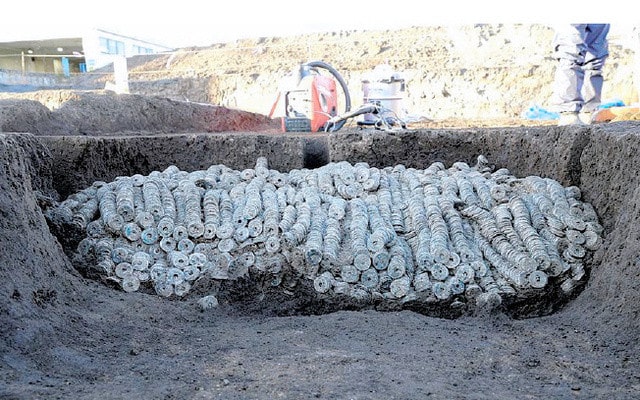In an astonishing turn of events, archaeologists conducting an excavation at the Sosha Village East 03 site in Maebashi City, Japan, uncovered a treasure trove of over 100,000 ancient coins! Among these artifacts are coins of Chinese origin that date back more than 2,000 years, offering a fascinating glimpse into the past.
The Excavation That Started It All
This significant excavation was set in motion due to the construction of a new factory in the Sojamachi district. What the construction team didn’t expect was to unearth such an extensive collection of historical currency.

A Glimpse into Ancient Currency
The cache includes the famed “Ban Liang,” which is recognized as China’s first unified currency from 175 B.C., alongside other coins that date from the seventh to the thirteenth centuries. What’s particularly intriguing is how these coins were bundled—each group containing around 100 coins tied together with straw cords known as “sashi.”
Archaeologists believe that these coins were buried in haste, likely as a precaution against impending conflict, given the site’s proximity to lavish homes belonging to influential figures in medieval Japan.
The Magnitude of the Find
The coins were found in a mound approximately 60 centimeters high and one meter wide, with an astonishing count of 1,060 bundles. Some of these bundles revealed evidence of up to 10 sashi each, equivalent to nearly a thousand coins, all neatly arranged with traces of rice straw mats.
This monumental discovery took place in Gunma Prefecture and has already piqued the interest of historians and archaeologists alike.

An Array of Coinage
Upon examining 334 coins from this remarkable haul, researchers identified an incredible variety of 44 different types of currency. These coins trace their origins from as early as China’s Western Han Dynasty and extend to the Southern Song Dynasty.
The oldest coin among the collection, the “Ban Liang,” features a diameter of 2.3 centimeters, a square hole measuring 7 millimeters in the center, and a thickness of just 1 millimeter. It bears inscriptions reading “liang” on the left and “ban” on the right.

The most recent coin dates back to 1265 during the Southern Song Dynasty, leading experts to speculate that these coins were hidden away during the tumultuous Kamakura period (1185-1333). It’s worth noting that these findings are preliminary and may be refined through further research.
Explore the Exhibition
The archaeological site is part of a broader area that includes significant historical landmarks like the Sosha burial mounds, the San’o Temple Ruins, and the Ueno Kokubunji Temple. This indicates that the region was a vital center of activity from the late Kofun period to the Ritsuryo period.
Currently, the extraordinary artifacts from the Sosha Village East 03 site are on display at the “Newly Excavated Cultural Artifacts Exhibition 2023” in Maebashi City’s Otemachi district. The exhibition is open to the public free of charge until the 12th of this month.
This discovery not only enriches our understanding of Japan’s history but also highlights the cultural exchanges that took place across regions. If you’re in the area, don’t miss out on this unique opportunity to witness history firsthand!

